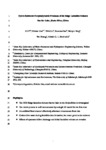Hydro-sediment-morphodynamic processes of the baige landslide-induced barrier Lake, Jinsha River, China
| dc.contributor.author | Li, J | |
| dc.contributor.author | Cao, Z | |
| dc.contributor.author | Cui, Y | |
| dc.contributor.author | Fan, X | |
| dc.contributor.author | Yang, W | |
| dc.contributor.author | Huang, W | |
| dc.contributor.author | Borthwick, Alistair | |
| dc.date.accessioned | 2021-08-22T10:37:41Z | |
| dc.date.available | 2021-08-22T10:37:41Z | |
| dc.date.issued | 2021-05 | |
| dc.identifier.issn | 0022-1694 | |
| dc.identifier.other | 126134 | |
| dc.identifier.uri | http://hdl.handle.net/10026.1/17643 | |
| dc.description.abstract |
A large landslide impacting a river may cause a multi-phase chain of hazards, comprising landslide-generated waves, inundation as a barrier lake develops upstream of a landslide dam arising from rapid sediment deposition, and downstream flooding due to barrier lake outburst. Two major landslides (each of volume ~ 107 m3) occurred successively on 10th October and 3rd November 2018 at Baige village, Tibet, China. Both landslides led to a natural dam that completely blocked the Jinsha River, along with a barrier lake filled with upstream river inflow. Although the first barrier lake breached naturally, a significant quantity of residual material from the first landslide dam was left behind without being eroded. After the second landslide occurred, a flood channel was urgently constructed to facilitate an artificial breach of the barrier lake as it formed. The Baige landslide-induced barrier lake is unique having triggered by two successive landslides and outbursts a mere five weeks apart. Here a computational investigation is presented of the hydro-sediment-morphodynamic processes of the Baige barrier lake, using a recent 2D double layer-averaged two-phase flow model. This is the first modelling study of the whole field and whole processes for the formation and outburst of a landslide-induced barrier lake as well as the resultant floods, without evoking presumptions on dam breach (which have prevailed for decades and bear much uncertainty). The computed results agree well with field observations in terms of landslide-generated waves, landslide dam morphology, stage and discharge hydrographs at the dam site and downstream flood hydrographs. The artificial flood channel is shown to be effective for alleviating downstream inundation. Water and grain velocities are demonstrated to be distinct, characterizing the primary role of grains in landslide dam and barrier lake formation and the dominant role of water in barrier lake outburst and the resultant flood. Relatively low inflow discharge and large initial landslide volume favour landslide dam and barrier lake formation, but delay the outburst and downstream flood. The present 2D double layer-averaged two-phase model holds great promise for assessing future landslide-induced multi-hazard chains in rivers, and informing mitigation and adaptation strategies. | |
| dc.format.extent | 126134-126134 | |
| dc.language | en | |
| dc.language.iso | en | |
| dc.publisher | Elsevier | |
| dc.title | Hydro-sediment-morphodynamic processes of the baige landslide-induced barrier Lake, Jinsha River, China | |
| dc.type | journal-article | |
| dc.type | Journal Article | |
| plymouth.volume | 596 | |
| plymouth.publication-status | Published | |
| plymouth.journal | Journal of Hydrology | |
| dc.identifier.doi | 10.1016/j.jhydrol.2021.126134 | |
| plymouth.organisational-group | /Plymouth | |
| plymouth.organisational-group | /Plymouth/Faculty of Science and Engineering | |
| plymouth.organisational-group | /Plymouth/Faculty of Science and Engineering/School of Engineering, Computing and Mathematics | |
| plymouth.organisational-group | /Plymouth/Users by role | |
| plymouth.organisational-group | /Plymouth/Users by role/Academics | |
| dcterms.dateAccepted | 2021-02-22 | |
| dc.rights.embargodate | 2022-2-26 | |
| dc.rights.embargoperiod | Not known | |
| rioxxterms.versionofrecord | 10.1016/j.jhydrol.2021.126134 | |
| rioxxterms.licenseref.uri | http://www.rioxx.net/licenses/all-rights-reserved | |
| rioxxterms.licenseref.startdate | 2021-05 | |
| rioxxterms.type | Journal Article/Review |


